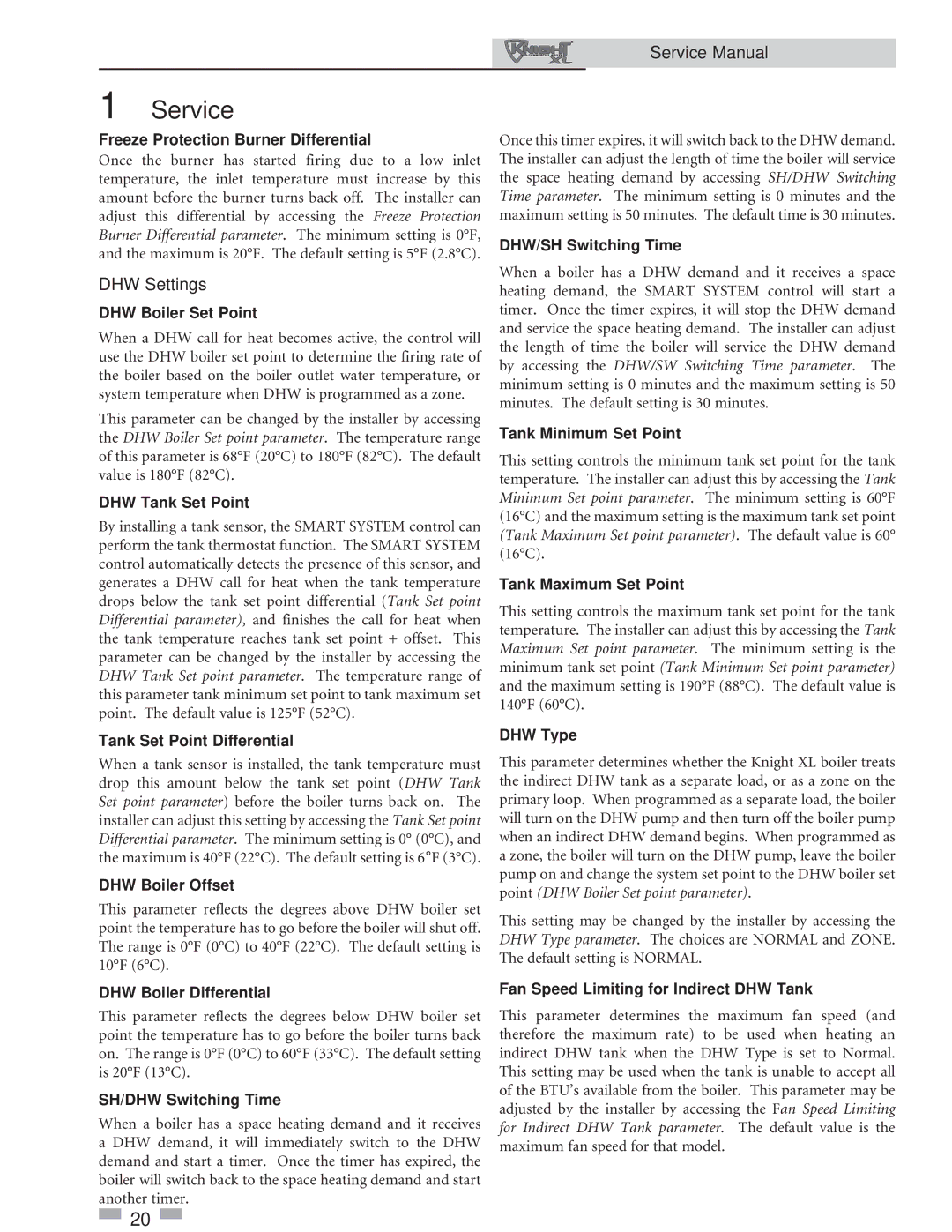1 Service
Freeze Protection Burner Differential
Once the burner has started firing due to a low inlet temperature, the inlet temperature must increase by this amount before the burner turns back off. The installer can adjust this differential by accessing the Freeze Protection Burner Differential parameter. The minimum setting is 0°F, and the maximum is 20°F. The default setting is 5°F (2.8°C).
DHW Settings
DHW Boiler Set Point
When a DHW call for heat becomes active, the control will use the DHW boiler set point to determine the firing rate of the boiler based on the boiler outlet water temperature, or system temperature when DHW is programmed as a zone.
This parameter can be changed by the installer by accessing the DHW Boiler Set point parameter. The temperature range of this parameter is 68°F (20°C) to 180°F (82°C). The default value is 180°F (82°C).
DHW Tank Set Point
By installing a tank sensor, the SMART SYSTEM control can perform the tank thermostat function. The SMART SYSTEM control automatically detects the presence of this sensor, and generates a DHW call for heat when the tank temperature drops below the tank set point differential (Tank Set point Differential parameter), and finishes the call for heat when the tank temperature reaches tank set point + offset. This parameter can be changed by the installer by accessing the DHW Tank Set point parameter. The temperature range of this parameter tank minimum set point to tank maximum set point. The default value is 125°F (52°C).
Tank Set Point Differential
When a tank sensor is installed, the tank temperature must drop this amount below the tank set point (DHW Tank Set point parameter) before the boiler turns back on. The installer can adjust this setting by accessing the Tank Set point Differential parameter. The minimum setting is 0° (0°C), and the maximum is 40°F (22°C). The default setting is 6°F (3°C).
DHW Boiler Offset
This parameter reflects the degrees above DHW boiler set point the temperature has to go before the boiler will shut off. The range is 0°F (0°C) to 40°F (22°C). The default setting is 10°F (6°C).
DHW Boiler Differential
This parameter reflects the degrees below DHW boiler set point the temperature has to go before the boiler turns back on. The range is 0°F (0°C) to 60°F (33°C). The default setting is 20°F (13°C).
SH/DHW Switching Time
When a boiler has a space heating demand and it receives a DHW demand, it will immediately switch to the DHW demand and start a timer. Once the timer has expired, the boiler will switch back to the space heating demand and start another timer.
 20
20 
Service Manual
Once this timer expires, it will switch back to the DHW demand. The installer can adjust the length of time the boiler will service the space heating demand by accessing SH/DHW Switching Time parameter. The minimum setting is 0 minutes and the maximum setting is 50 minutes. The default time is 30 minutes.
DHW/SH Switching Time
When a boiler has a DHW demand and it receives a space heating demand, the SMART SYSTEM control will start a timer. Once the timer expires, it will stop the DHW demand and service the space heating demand. The installer can adjust the length of time the boiler will service the DHW demand by accessing the DHW/SW Switching Time parameter. The minimum setting is 0 minutes and the maximum setting is 50 minutes. The default setting is 30 minutes.
Tank Minimum Set Point
This setting controls the minimum tank set point for the tank temperature. The installer can adjust this by accessing the Tank Minimum Set point parameter. The minimum setting is 60°F (16°C) and the maximum setting is the maximum tank set point (Tank Maximum Set point parameter). The default value is 60° (16°C).
Tank Maximum Set Point
This setting controls the maximum tank set point for the tank temperature. The installer can adjust this by accessing the Tank Maximum Set point parameter. The minimum setting is the minimum tank set point (Tank Minimum Set point parameter) and the maximum setting is 190°F (88°C). The default value is 140°F (60°C).
DHW Type
This parameter determines whether the Knight XL boiler treats the indirect DHW tank as a separate load, or as a zone on the primary loop. When programmed as a separate load, the boiler will turn on the DHW pump and then turn off the boiler pump when an indirect DHW demand begins. When programmed as a zone, the boiler will turn on the DHW pump, leave the boiler pump on and change the system set point to the DHW boiler set point (DHW Boiler Set point parameter).
This setting may be changed by the installer by accessing the DHW Type parameter. The choices are NORMAL and ZONE. The default setting is NORMAL.
Fan Speed Limiting for Indirect DHW Tank
This parameter determines the maximum fan speed (and therefore the maximum rate) to be used when heating an indirect DHW tank when the DHW Type is set to Normal. This setting may be used when the tank is unable to accept all of the BTU’s available from the boiler. This parameter may be adjusted by the installer by accessing the Fan Speed Limiting for Indirect DHW Tank parameter. The default value is the maximum fan speed for that model.
